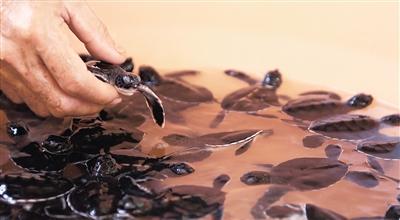Tender love extended to protect sea turtles
- By Wu Jin
 0 Comment(s)
0 Comment(s) Print
Print E-mail China.org.cn, November 20, 2018
E-mail China.org.cn, November 20, 2018

In November, the weather remains hot in Sansha, a coastal city of China's tropical Hainan province. However, under the scorching sun, a host of private "coastguards" patrolled the beach, concentrating on the movements of sea turtles while evaluating changes in the local environment.
"The most difficult moment concerning a sea turtle's lifeline is when the creature hatches and manages to crawl from sand to sea," said Huang Hongbo, chief of Sansha's North Qilianyu Island, a 0.4-square-kilometer islet that sea turtles have turned into a prime nesting place.
Huang can still remember how thriving sea turtles were on North Qilianyu in 1967, when ocean pollution and excessive fishing were not as devastating as they are today.
To address the grim prospect of sea turtles becoming extinct, China has categorized them as subject to class-II [endangered species] protection.
In 2012, Sansha created an encircled area as a nature reserve for sea turtles to escape from external disturbances.
According to Huang, sea turtles are used to laying eggs on the spot where they were born after reaching adulthood around the age of 20. "Sea turtles love to lay eggs deep at night, however, the processes can be easily disturbed by the differentiation of sand qualities, height of the tide, sounds and streams of light," he added.
A sea turtle usually lays eggs no more than five times in a year with up to 120 eggs each time; however, despite the almost 100% hatching rate, infant mortality is high.
"They should not be laid near the sea because the tide may affect the hatching process, nor should they be laid too far away from the sea, otherwise, their lives are put at risk while heading towards the sea," Huang said, pointing out that they can easily succumb to predators, such as crabs and sea birds.
By turning from fishers to protectors, the coast patrollers have received professional training to assist the fragile young turtles to reach the sea.
"Once upon a time, a sea turtle's flipper was found split by a fishing net. The coastguards had spent several months taking care of it before releasing it back to the sea," said Chen Shan, the island's chief turtle protector.
From 2014 to 2018, the number of sea turtle clutches in the island grew from 52 to 114 in a row, forming a compelling scene in the nature reserve.
"The cluster of sea turtles becomes an amazing sight on the island, which is worthy the lifetime protection from humans," said Huang.






Go to Forum >>0 Comment(s)